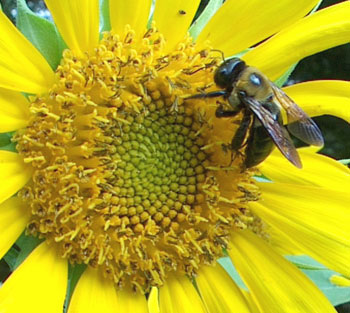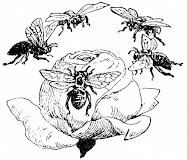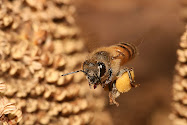
MARCH: A Great Invitation
Honeybees are excellent guides to the natural world. With a whiff of nectar or a taste of pollen, and a quick dance lesson, returning foragers relay precise directions to the waiting group of worker bees. They will find the food source with little difficulty. The success of the hive depends on this accurate communication.
Bees can also guide the rest of us. They're able to find pollen, nectar, and propolis even when it seems that nothing is in bloom. On a sunny, snow-covered day in February, chances are good that the bees are out and about, bringing in whatever the plants provide. It's remarkable, really, even for those of us in tune to the plants around us. But the bees and plants have been partners for far longer than we've been paying attention. There's much yet to learn.
So the next time you pass a tree or shrub, maybe a flower planting full of bees, consider the buzz an invitation: something wonderful is happening here, an experience open to all who place themselves under the influence of plant and pollinator. Won't you stop and look?

APRIL: Spring Gathering
What a spring! Perhaps we were due for some great weather after last year’s poor fall flow and the February snowmageddon. Whatever the cause, I’ll take it.
Here are some of the blooming plants that I’ve been keeping an eye on this spring:
Daffodils: The heralds of spring, all brass and circumstance standing in the late winter mud. Too bad they’re not very interesting to bees, as they’re often abundantly planted. Too many toxic alkaloids, perhaps, and not enough pollen.
Crocuses: Playing a quick game of peek-a-boo before taking their leave, the crocuses provide some pollen to bees. The crocuses around me are usually pretty sparse and only seem to be out in damp, cool weather, but I think that a mass planting could be attractive to bees if there’s a sunny day while they’re blooming.
Maples: Maple trees showed up on a lot of my pollinator research lists, so I was watching for bees in maples. Apparently I don’t know what exactly to look for as I didn’t see much happening. Now the seeds are fully formed and ready to whirl, so I’ll have to wait until next year’s buds to look again.
Bradford Pears: Not so delicately referred to as “tuna on a trunk” by Southern Living's garden blogger Steve Bender, (http://grumpygardener.southernliving.com/grumpy_gardener/2009/03/bradford-pear-.html), this tree used to be a favorite of urban developers. Consequently, there are lots of mature Bradford Pears around the boulevards and business districts. I liked the effervescent white blooms, but is there any buzz in this tuna bubbly? In theory, all pear trees should be ok for bees, but the stink of these trees might be more attractive to flies.
Redbud: One of spring’s most striking colors and good for bees. We should all get to know the redbud a little better.
Apple, Crabapple: Lots of blooming crabapple trees around town right now, so head out and look for bees. The larger bumblebees, in particular, are neat to watch bobbing around the blossoms.
Dogwood: Slender and elegant, attractive to a wide range of pollinators. Still in bloom at the moment.
Hawthorn: There are a few hawthorn volunteers at the apiary site. It appears that they’ve already flowered.
Dandelions: A key plant for bees and beekeepers. By my account, the first dandelion showed its trusting face in late March with the full bloom coming shortly thereafter during the warm period in early April. They’re now starting to go to seed, if they haven’t already been mowed down.

Violets: Another great lawn wildflower. There’s a kind of white butterfly or moth that I like to watch flit about the violets.
Forget-me-nots: A good symbolic plant for your true love’s tussie-mussie, particularly if your true love is a bee. So find a field of forget-me-nots, drink tea, and spend afternoons measuring time in spoons. It’s that kind of plant.
Ok, what have I missed? Where are the bees in your garden and neighborhood?
- - - Jeff Irwin

Post your comments to Jeff - and observations on what's UP in your neck of the woods - directly below.
And watch for Jeff's column on the First Sunday of every month.
- - - a Victorian tussie-mussie




No comments:
Post a Comment